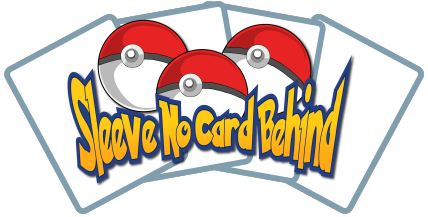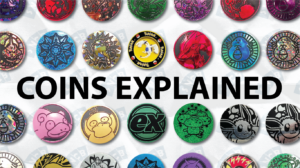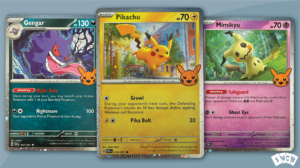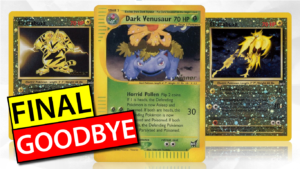-
By: Oliver Copeland
- Published:
- Last Updated: December 3, 2023
It’s kind of funny how one can be collecting Pokémon cards for so long but still learn new things every day. For those of us who don’t actively play the TCG, there’s a whole realm of information that we just don’t need to know.
In this article, we’ll cover all of what the letters mean at the bottom of Pokémon cards in both English and Japanese.
What The Letters Mean At The Bottom Of English Pokémon Cards
Most of you (as well as myself) will be more familiar with English cards, so let’s dive into the domestic differences first.
Regulation Mark
At the bottom left of a modern Pokémon card will be a letter in bold with a white background. This is called a Regulation Mark.
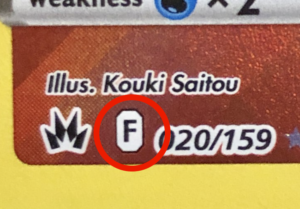
To a collector, this means nothing. However, this mark is important to a TCG player since it determines the card’s legality in the current format. For example, ‘D’ may be legal to play this year, but as we transition into the next year and the format changes, ‘D’ cards will be rotated out.
You can’t just build a deck out of whichever cards you want when playing in tournaments or other events. There is a current format to follow. This keeps the game fair and allows players to strengthen their skills through problem-solving and deck-building skills.
Collector Number
To the right of the regulation mark is where you’ll find the Collector Number.
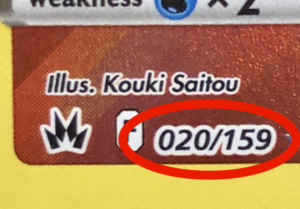
This is typically formatted as X/XYZ or similar, but sometimes it can be different. For example, Sword & Shield promo cards have a collector number such as SWSHXYZ, indicating its place in the list of promo cards for that era of cards.
If one was to organize their cards into a binder, they would typically use the collector number as a guide, ordering them sequentially.
The collector number is also used to identify specific cards. For example, you might type “Alakazam 1/102” into Google to find the Alakazam from the 1999 Base Set.
Set Symbol
Non-Japanese Pokémon cards have a symbol to designate the expansion set they belong to.
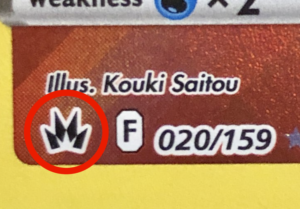
This has been the case ever since the Jungle expansion set was released in 1999. The symbol for Jungle is the flower that belongs to the Pokémon Vileplume.
However, today the symbols are more abstract and often don’t relate directly to a Pokémon.
A promo card will not have a specific set symbol but instead a black star with the word “PROMO” in it. This tradition goes back to 1999 and is referred to as “Black Star Promos.”
Rarity Symbol
English Pokémon cards have used symbols to denote rarity ever since the original release in 1999 (starting to see a pattern?). You can find the Rarity Symbol in the bottom left or bottom right of a card.
Most cards are one of three rarities:
- Common
- Uncommon
- Rare
But many other symbols are used to indicate more rarities. For example, the Shining Pokémon of the Neo Series use three stars in a triangle pattern. We’ve included an infographic to make things easy.
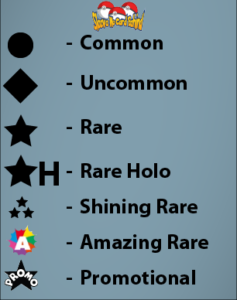
It’s worth noting that promo cards do not have a rarity symbol. These are promotional cards given out at special events or with other Pokémon TCG products such as games, magazines, and sometimes pre-order bonuses.
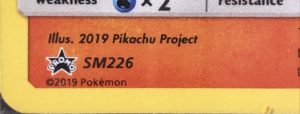
This means that promo cards can be in great supply or sometimes incredibly rare.
Scarlet & Violet Rarity Symbols Explained
With the release of Scarlet & Violet, The Pokémon Company International has made a few extra changes.
The rarity system has gotten an overhaul. Common and Uncommon rarities have stayed the same, but everything else has been upgraded.
All Rares Are Now Holo
That’s right, all rare cards are now holo. The days of pulling a non-holo rare are gone, and we now have a guaranteed holo rare in each booster.
Of course, we still get reverse holo cards, so that’s a guaranteed two holo cards per pack. Pretty sweet. That being said, the rare rarity symbol remains a single star.
Aligning With The Japanese
The Pokémon Company International announced that they will be bringing both the English and Japanese TCG together, uniting them as one.
Changing the rarity system is a big part of this since the English version has drifted so far from the Japanese roots that birthed it.
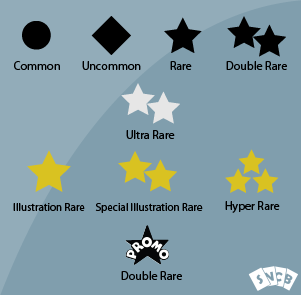
What The Letters Mean At The Bottom Of Japanese Pokémon Cards
Of course, Pokémon originated in Japan, but many of the regional differences we have today are a result of Wizards of the Coast.
WotC had the distribution and publishing rights to launch the Pokémon TCG in North America in 1999. WotC was already publishing Magic: The Gathering, so they used a lot of ideas and resources from their already successful TCG to launch Pokémon.
WotC never set foot in the Japanese Pokémon market though, so when you open a pack of Japanese cards, you’ll notice quite a few differences.
Set Abbreviation
The first thing you’ll notice at the bottom of a Japanese card is the set abbreviation. Japanese cards do not have a set symbol.
Beginning with the HeartGold & SoulSilver era in 2009, Japanese cards switched to a small abbreviation to denote the expansion set the card belonged to.
The abbreviations are sometimes difficult to correlate since there is a translation from a Japanese word to the English spelling of that Japanese word.
For example, Sun & Moon cards have an abbreviation of ‘SM’, followed by the set number, followed by an ‘a’ if it’s a two-part set.
Scarlet & Violet cards will have ‘SV’, obviously meaning Scarlet & Violet.
In the scenario that the card is a promo, the abbreviation will be replaced with the word ‘PROMO.’
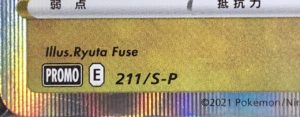
Regulation Mark
The regulation marks themselves stay the same from Japanese to English, but the TCG format does not.
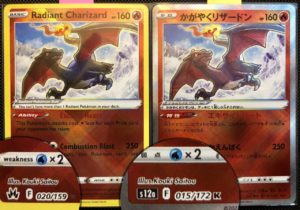
Radiant Charizard has an ‘F’ regulation mark in both languages because it is the same card. When the format shifts or a rotation occurs, it is region specific. This means that Japan may rotate while Global (English) does not.
But in terms of the card itself. A regulation mark is unchanged between Japanese and English.
Collector Number
Much like the regulation mark, the collector number means the same thing in Japanese but this time you’ll notice that the numbers are different.
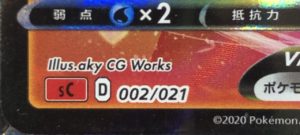
Japanese sets are released a few months before the cards are available globally. Also, Japanese expansion sets are much smaller and more frequent. Most of the time, two Japanese expansions will be combined into one for the global market.
All this means is that the collector number will be different on Japanese and English cards, but still serve the same purpose.
Rarity Symbol
Ok, this is where we start to see some bigger differences between Japanese and English.
Beginning with the Black & White era in 2010, Japanese cards switched from rarity symbols to letters.

Final Thoughts
Hopefully, that answers your questions and covers the slightly confusing history and explanation of all the little symbols on a Pokémon card. Recently we got the news that the Japanese and Global cards would be getting unified starting with the Scarlet & Violet era of cards.
Maybe this will clear up some of the confusion! But until then, this guide is here for you.

Hi, I'm Oliver. I've been collecting Pokémon cards for 25+ years. I hope you enjoyed your read and learned something. Learn more about me on the About page.
